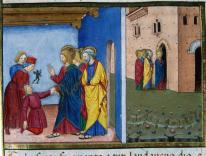The drive from New Orleans west to Louisiana State Prison drags on toward Baton Rouge through long flat stretches of nothing but cypress swamps and sudden, torrential rains thatblind the driver to all but the tail lights of a car a few yards in front.
North of Baton Rouge, Highway 61 slowly turns "scenic." The landscape gently rolls, and forests and lines of ancient live oaks shelter what the tourist signs announce as "Antebellum Homes," vast slave plantations that before the Civil War lined the banks of the Mississippi River. Sr. Helen Prejean, of the Sisters of Saint Joseph of Medaille, has been making the trip to the state prison popularly known as Angola (because historically the slaves around here came from Angola in Africa) every month for more than twenty years. On five of these trips she has watched a man die.
This is the last Friday in June, and she will visit Eddie Sonnier and Manuel Ortiz. I hope to see Ortiz as well. In 1977, when Eddie was twenty, he and his older brother Pat (twenty-seven), squirrel hunting, came upon a young couple on a lovers' lane, kidnapped them, raped the girl, and shot both in the back of the head. The court, in spite of a last-minute confession by Eddie, held that Pat had pulled the trigger and sentenced him to death and Eddie to life in prison. Prejean was Pat's first death-row pen pal, as well as his spiritual adviser until his execution in 1984, which she witnessed.
The second prisoner she will see is on death row. Manuel Ortiz is a Salvadoran and a former New Orleans businessman, convicted of murdering, in 1992, both his wife and her woman friend. His lawyer, Nick Trenticosta, of the Center for Equal Justice, calls the case against Ortiz weak. It was based largely on the testimony of an informer who said that Ortiz had once asked if he would kill someone for him. Ortiz was out of the country when the murder took place, and the prosecution suppressed evidence pointing to other suspects. Sr. Helen believes she is counseling an innocent condemned man.
Trenticosta, one of the nation's leading anti-death-penalty activists, also wonders about the mystery of Helen Prejean: How does she keep going? She began as a poor little nun willing to correspond with a prisoner and ended up writing a best-selling book, Dead Man Walking, that was made into a popular movie with Susan Sarandon in the role of Sr. Helen Prejean. Prejean is the recipient of twenty-four honorary degrees and is a national celebrity so overwhelmed by her speaking schedule that she can barely keep track of where she is. A "general" in the worldwide movement to abolish the death penalty, she has three times been nominated for the Nobel Peace Prize. Yet she continues her monthly seven-hour round-trip drives to Angola to look these God-forsaken men in the eyes.
Death row is situated in a wing of the long, low administration building, perched on the highest point of the eighteen-thousand-acre farm. The prison extends into the Mississippi River, which surrounds the farm on three sides. It was known in the 1960s as the "bloodiest prison in the South," but a series of reform-minded wardens, particularly the current one, Burl Cain, have attracted national and international attention. Angola has been the focus of several sympathetic TV documentaries, as well as a critical book, Daniel Bergner's God of the Rodeo (1998), on the annual popular rodeo where convicts ride wild bulls and break many bones.
Last December six convicted murderers took three guards hostage and beat and stabbed one to death before guards crushed the rebellion and killed an inmate. The incident is seen as both an exception to the usual order and a brutal reminder that some of the 5,100 Angola inmates are desperate men. With more than 60 percent serving life without parole and many others knowing they will die before their terms are up, hope is in short supply. The prisoner whom the guards killed had earlier told Warden Cain, "I've got nothing to lose. I came here as a young man. I'm going to die in prison."
Prejean makes her way to the visiting room to try to deliver a little hope to Eddie Sonnier and Manuel Ortiz. She knows that mostly they will talk small talk; but she also prays that the new national and international discussion of the death penalty will offer Ortiz a glimmer of light.
Meanwhile, I am ushered into the warden's office. At his door is a beautiful Western saddle and near the conference table a handmade spinning wheel, proud products of the prisoners' craft shop. Cain, fifty-eight, is a short, heavyset man with a tan, lined face. He sits at the end of his office conference table, with two witnesses, his assistant Cathy Jett and a university professor friend, as he tells me why I may not talk to Manuel Ortiz on death row. Cain describes himself as a ship captain in a storm who must navigate between the rocks and the waves. He knows I will write a book or article against capital punishment, so he cannot identify himself with my project.
He has gotten good coverage for running a humane, "Christian" prison. He has eaten last meals with condemned men and held their hands at the end. The documentary film, The Farm, records how his leadership during the 1997 flood that inundated much of the low-lying prison land won the respect of the inmates. But he was "burned" by Daniel Bergner's book. Cain gave the writer yearlong access to the prison; then the author embarrassed him by detailing prisoners' homosexual acts and by depicting the rodeo as a "perverse," thirty-two-year-old tradition that seriously injures inmates desperate for a few seconds of fame. So no, I may not see death row, but his assistant will give me a tour of the grounds.
HOLLYWOOD'S VERSION
The museum at the gate to the Louisiana State Prison displays a replica of one of the prison's degrading little cells, where the visitor can pose and have his or her picture taken for three dollars. We see the original electric chair, used from the 1940s to 1991—wooden, with big leather straps and sponges to transmit the current. There's even an exhibit on the film Dead Man Walking, with pictures of the three inmates who inspired the film, and the orignal film script with Sr. Helen's comments. The script is open to the scene where, in 1982, the old school prison chaplain warns Prejean that real prisons are not like the movies and real prisoners are not like James Cagney; they are "the scum of the earth." In the film he also tells Prejean she should dress like a "real" nun.
There are several levels of irony in the scene. Prison movies, as a genre, are peopled with innocent victims behind bars and oppressive thugs wearing the uniform of law and order. A heroic lawyer, played by Henry Fonda, will snatch the temporary victim of injustice from the electric chair five minutes before midnight.
The first irony is that, though the prisoners are human beings and not scum, the men on whom the composite film inmate was based, Patrick Sonnier and Robert Lee Willie, were guilty of stomach-turning crimes. Producer Tim Robbins and Susan Sarandon were determined to purge the script of the usual prison-film sentimentality, to produce an "anti" death-penalty work of art which would give both opponents and proponents evidence for their case.
So, though both Sonnier and Willie were electrocuted, the Sean Penn character dies by lethal injection. In this way the very fact of his death—apparently clean, peaceful, and painless—must horrify the viewer, if he or she is to be horrified; or the death may seem fitting, deserved.
A few weeks after I watched that scene on video, I was wheeled into a hospital operating room for spinal cord surgery. The operating table, narrow, with the outstretched arm, was the same as the execution chamber's; the room's walls were plain and bare, and a ceiling light glared down at me; men and women in uniforms huddled around; someone took my arm, sterilized a spot with a gauze, pierced a vein with a needle, and sent a serum into my system—and then everything was gone. When I came to, four hours later, it occurred to me that I had gone through, but not experienced, the oblivion of death. Perhaps this is what the general public imagines death by lethal injection except for the anxiety of anticipation-to-be. If there is another world on the other side of darkness, we will have what we deserve; if not, we will never know.
The final irony is that the naive nun would one day become the heroine of a prison movie and one of the world's leading spokespersons for the idea that there are no "scum" among our fellow human beings. The public usually imagines movie stars to be more glam orous and interesting than the real-life characters they portray; in fact, the real Helen Prejean may be less glamorous but she is much more exciting, complex, and above all funnier than Sarandon's portrayal.


